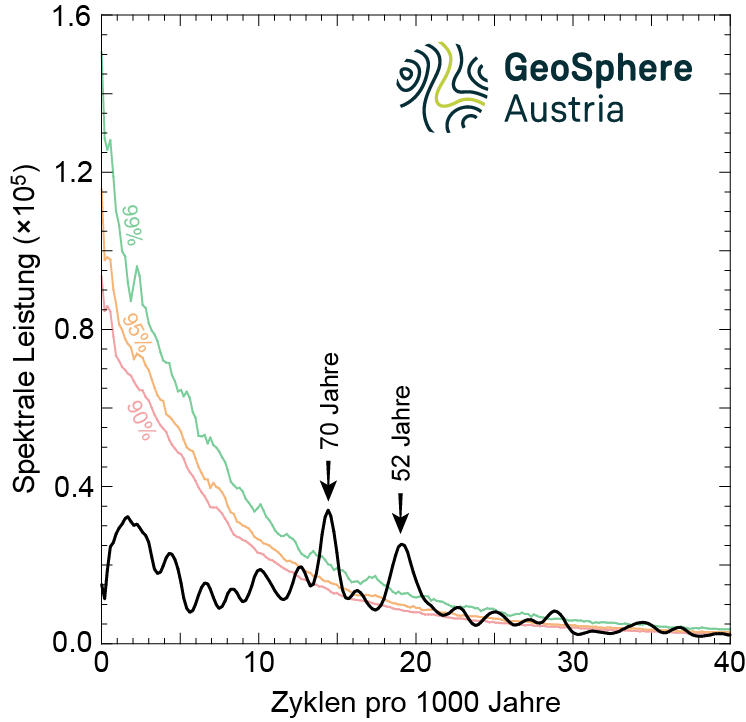Thousands of years of climate cycles deciphered with sediments from lakes
In collaboration with the University of Otago (New Zealand), a team from GeoSphere Austria has been able to demonstrate a cyclical climate pattern in New Zealand sediments dating back more than 10,000 years, which changed from wet to dry every 50 to 70 years. Using special geochemical and palaeomagnetic methods, this is the first time that short-term climate fluctuations have been detected in very old sediments. The study was recently published in the renowned journal Nature Communications. The research team is also planning to use these methods to analyse lakes in Austria.
The study ‘Younger Dryas drought and IPO climate modulation during the Antarctic Cold Reversal in New Zealand’ was published in April 2025 in the journal Nature Communications.
It was the result of a collaboration between Catherine Beltran (GeoSphere Austria, Head of Geoanalytics), Ramon Egli (GeoSphere Austria, Head of General Geophysics) and the head of the study Christian Ohneiser (University of Otago in New Zealand and University of Vienna).
The research team gained new insights into the climate history of the last 16,500 years, i.e. since the final phase of the last ice age, from a layer of sediments around six metres thick in Lake Hayes on the South Island of New Zealand.
Sediments are tiny particles such as sand and clay or the remains of plants and animals that have been deposited layer by layer at the bottom of lakes and seas over thousands of years. Analyses of these sediment layers allow conclusions to be drawn about the climate at the time they were deposited.
The research team used highly developed geochemical and palaeomagnetic techniques to analyse the sediments in Lake Hayes in New Zealand.
‘In the sediments deposited 13,000 to 14,700 years ago, we discovered a climate cycle that changed from wet to dry every 50 to 70 years,’ says geological climate reconstruction specialist Catherine Beltran, who heads the GeoSphere Austria's Geoanalytics department, ’We were also able to detect an extreme drought that lasted for several centuries around 12,000 years ago. This study showed for the first time that past climate changes in New Zealand can be reconstructed with high precision using state-of-the-art techniques. We are planning to apply these methods to sediments in Austria's lakes.’
The sediments were analysed using various chemical and magnetic methods. ‘We were able to detect the climate cycle using very small concentrations of iron minerals that had formed in the sediment. This also included greigite, a rarely occurring iron sulphide that is excreted after the oxygen in the sediment has been completely consumed,’ explains Ramon Egli, Head of the General Geophysics Department at GeoSphere Austria. ’The tiny greigite crystals, which are only a few tens of millionths of a millimetre in size, are likely to have been produced in part by a special type of iron-reducing bacteria before excretion continued inorganically at higher sulphide concentrations. This observation gives us a precise idea of the chemical conditions that prevailed on the lake floor shortly after sediment deposition and thus allows us to draw conclusions about the climate. This is because the conditions at the bottom of the lake are strongly influenced by the climate, for example by temperature, precipitation, water level and nutrient supply.’
The research team plans to apply similar methods to the study of lakes in Austria. Insights into past climate changes can help to make predictions more accurate, especially with regard to the coupling between global and regional climate changes.
‘A big unknown is the influence of the Atlantic Multidecadal Oscillation (AMO) on Austria. The AMO is a 60-year cycle of ocean temperature in the Atlantic that influences the climate in the northern hemisphere,’ say Beltran and Egli, ’current predictions about the impact of the AMO on spring snowfall and summer temperatures are based on climate modelling and climate data from the last few centuries. But we have very little information about changes in the AMO going back several thousand years and their influence on the climate in Central Europe. It is therefore important to gain further insights from sediments in Europe, for example from Austria's lakes.’
Translated with DeepL.com (free version)

